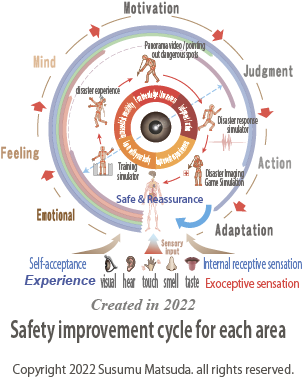As I mentioned in episode 6, the human experience process is the experience of events through the five senses → the generation of emotions → the generation of emotions → the generation of hearts (the state recognized by the brain) → the motives are born → collated with past data. In the case of a judgment based on the judgment or a new event, the judgment based on the prediction through intuition from the situation → the action according to the judgment → if the obstacle can be overcome, it will be in a state of adaptation. If it is determined that the failure cannot be dealt with, the process returns to the decision process and the process is restarted. This process of re-progress is a process of trial and error until the failure is resolved. However, if the failure is too large, it cannot be dealt with due to time out and it is recorded as a failure. Failure in the event of a disaster can hurt your body and, in the worst case, lead to death. Therefore, it is important to find a way to deal with these obstacles and improve their ability to respond in order to protect human life. We divide these experience processes into five, find means to improve responsiveness at each stage, and at the same time provide educational means to improve responsiveness and make further improvements.

First, the experience process is divided into the following five. Remember with your body Increased risk sensitivity. Develop the ability to notice. Promote judgment and action. There is a total of five to improve the ability to deal with obstacles. In the process of learning with the body, the ability to respond is improved by using a simulator method according to the three themes of repeatedly learning the work with the skill training simulator, acquiring console operation, and handing down and transmitting the corresponding skill with the body. The process of improving danger susceptibility improves danger susceptibility by learning about dangerous events through disaster case study videos and VR disaster experience and experiencing the fear of the disaster. In the process of cultivating the power of awareness, a camera is used to convert the actual work site into VR, and training is conducted to find out the risk factors that cause disasters safely in a practical manner. Improve awareness by using a pointing training simulator (RiMM360VR Advance) that uses panoramic images of the site. The process of judgment and action promotion simulates dangerous events and obstacles in actual disasters with a VR simulator and improves judgment with a simulator that promotes and trains judgments and actions for dealing with the obstacles. Disaster case studies are a key factor in this decision. By learning how to protect yourself through learning about disaster cases and knowing the fear of disasters, you can deepen your education. These improve judgment and behavior in the event of a disability. Finally, the process of disaster response capability improvement, which involves trial and error, involves improving the ability to respond to unknown disasters. It is necessary to provide comprehensive training and education, including the four processes already mentioned. In order to eliminate unexpected disasters, we perform virtual disaster simulations and find out how to deal with them through trial and error during training. This will improve your disaster response capabilities.